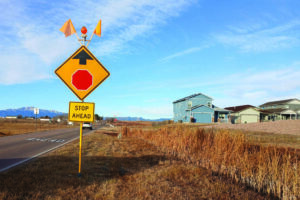Longtime local journalist Bill Radford and his wife, Margaret, live on 5 acres in the Falcon area with ducks, chickens, rabbits, dogs, cats, two noisy parrots, goats and two horses. Contact Bill at billradford3@gmail.com.
As we prepare to say goodbye to another summer, we’ve already bid farewell to an assortment of summer visitors.Avian visitors, that is.The summer before, we had welcomed a pair of swallows that built a nest on the south side of our house under the eaves. Swallows returned this year, as they’re known to do. (You’ve heard of the swallows of Capistrano, right?) This time, it appeared to be two pairs of swallows working together that constructed a nest in the same spot as the summer before. But then, oddly, they never seemed to occupy the nest. Perhaps they couldn’t come up with a joint tenancy agreement.Meanwhile, a pair of what appeared to be Western kingbirds built a nest out front. And they quickly made clear their belief that the front lawn was their territory, not ours. As allaboutbirds.org notes, Western kingbirds “ferociously defend their territories with wing-fluttering, highly vocal attacks. Vocalizations include long series of squeaky, bubbling calls as well as single, accented kip notes.””The Guide to Colorado Birds” by Mary Taylor Gray describes the kingbird’s cry as “a shrill, metallic twitter that sounds like a tape on fast-forward.” While it could have been irritating, my wife and I found the ruckus they created anytime we stepped out front to be hilarious. Admittedly, the kingbirds were likely not as amused.We never spotted the babies, but they were clearly there as the kingbirds constantly flew off, then returned with food for their offspring. Both male and female are known to feed their nestlings.Allaboutbirds.org offers this description: “Western kingbirds are fairly large flycatchers with large heads and broad shoulders. They have heavy, straight bills, long wings and a medium-length, square-tipped tail.” They’re gray-headed with a yellow belly and a whitish chest and throat.The website notes that kingbirds live in open habitats, where they perch on utility lines, fences and trees. They prefer valleys and lowlands, including grasslands, deserts, sagebrush, agricultural fields and open woodlands.Another welcome visitor this summer was a mockingbird; it greeted us each morning with its amazing and delightful variety of songs. While both female and male mockingbirds sing, the male is more vocal. “A male’s repertoire often contains more than 150 distinct song types which change during its adult life and may increase in number with age,” states birdsna.org, the Cornell Lab of Ornithology Birds of North America website. “Songs are acquired through imitating the calls and songs of other birds, the vocalizations of non-avian species, mechanical sounds, and the sounds of other mockingbirds.”We’re hoping he comes back next summer with even more songs.Garrett: The man, the roadSeveral months ago, I wrote about the origins of some county roads. Recently, I stumbled across the man I believe Garrett Road is named after: John Witwer Garrett. Though I don’t know for sure, Garrett is certainly a figure who deserved having a road named for him.A profile on the website of the AdAmAn Club hails Garrett as “a man of many accomplishments.”The profile reads, îFor several years, he was the national trapshooting champion in addition to being an accomplished hunter, fisherman and guide, a mountaineer, the second man added to the AdAmAn Club and proprietor of the Jno. Garrett Sporting Goods store. He also proved to be an advertising bonanza for the Winchester Arms company. He frequently provided shooting demonstrations during rodeos, parades and county fairs to co-promote ‘the superior quality of Winchester Armsí and his own business.””There was not a more enthusiastic and interesting talker in the city when it came to nature lore and sports,” according to Garrett’s obituary in ìThe Colorado Springs Evening Gazette.î “Mr. Garrett knew the mountains and the plains, the rivers and the stars, and the ways of wild animals were familiar to him. His memory was clear and often he would create word pictures of early days in Colorado Springs that possessed all the atmosphere of those colorful times in the West lived over again.îGarrett’s death in 1937 was sudden, the result of a heart attack. He was 72.”Death came as he was standing on the running board of an automobile shooting clay pigeons in a demonstration on the street,” the obituary read. “In recent years he frequently consented to exhibit his skill in the interest of some civic affair, and he had undertaken to ride about town breaking targets, as a publicity stunt for the Will Rogers rodeo. A start had been made at Costilla and Tejon streets, and the car had been driven as far north as Colorado Avenue when Mr. Garrett suffered the attack. He slumped forward into the front seat. Persons standing by thought he had reached over to pick up something and were startled when the car was pulled to the curb and he was lifted out unconscious.”





